English in Media: Analyzing Driverless Cars and Societal Changes
VerifiedAdded on 2021/04/24
|7
|1568
|54
Essay
AI Summary
This essay delves into the transformative impact of driverless cars on society, examining both the advantages and disadvantages of this emerging technology. It highlights how self-driving vehicles could improve road safety, reduce accidents, and minimize pollution through the use of clean energy. The essay addresses potential challenges, such as public acceptance, cybersecurity risks, and job displacement for drivers. It also explores the ethical considerations related to accident liability and the need for government regulations and driver retraining programs. The author references several studies and research papers to support the arguments and emphasizes the need for skilled programmers and ethical guidelines to ensure the successful integration of driverless cars into modern life. Overall, the essay provides a comprehensive overview of the opportunities and threats associated with autonomous vehicles and their potential to reshape transportation and society.
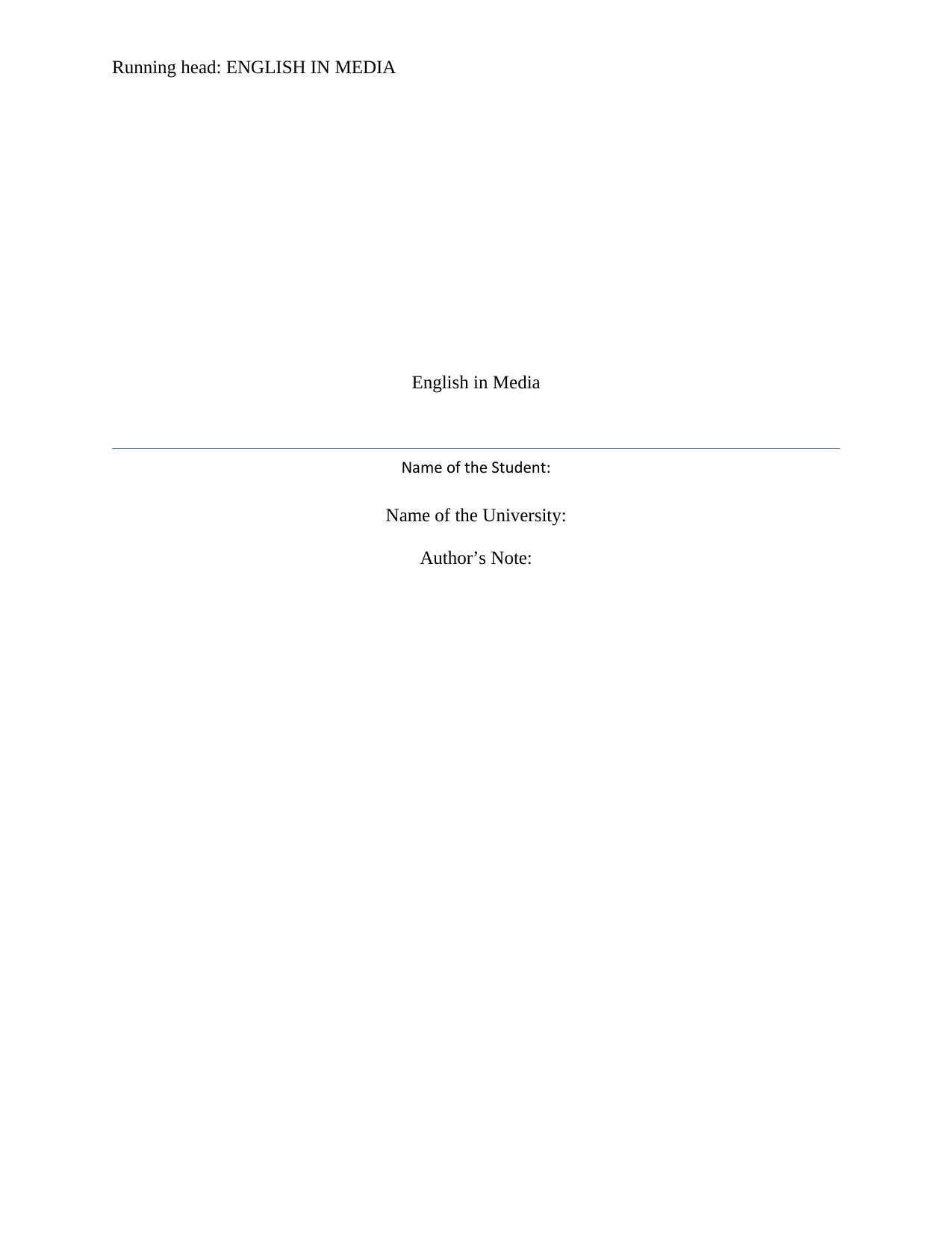
Running head: ENGLISH IN MEDIA
English in Media
Name of the Student:
Name of the University:
Author’s Note:
English in Media
Name of the Student:
Name of the University:
Author’s Note:
Paraphrase This Document
Need a fresh take? Get an instant paraphrase of this document with our AI Paraphraser
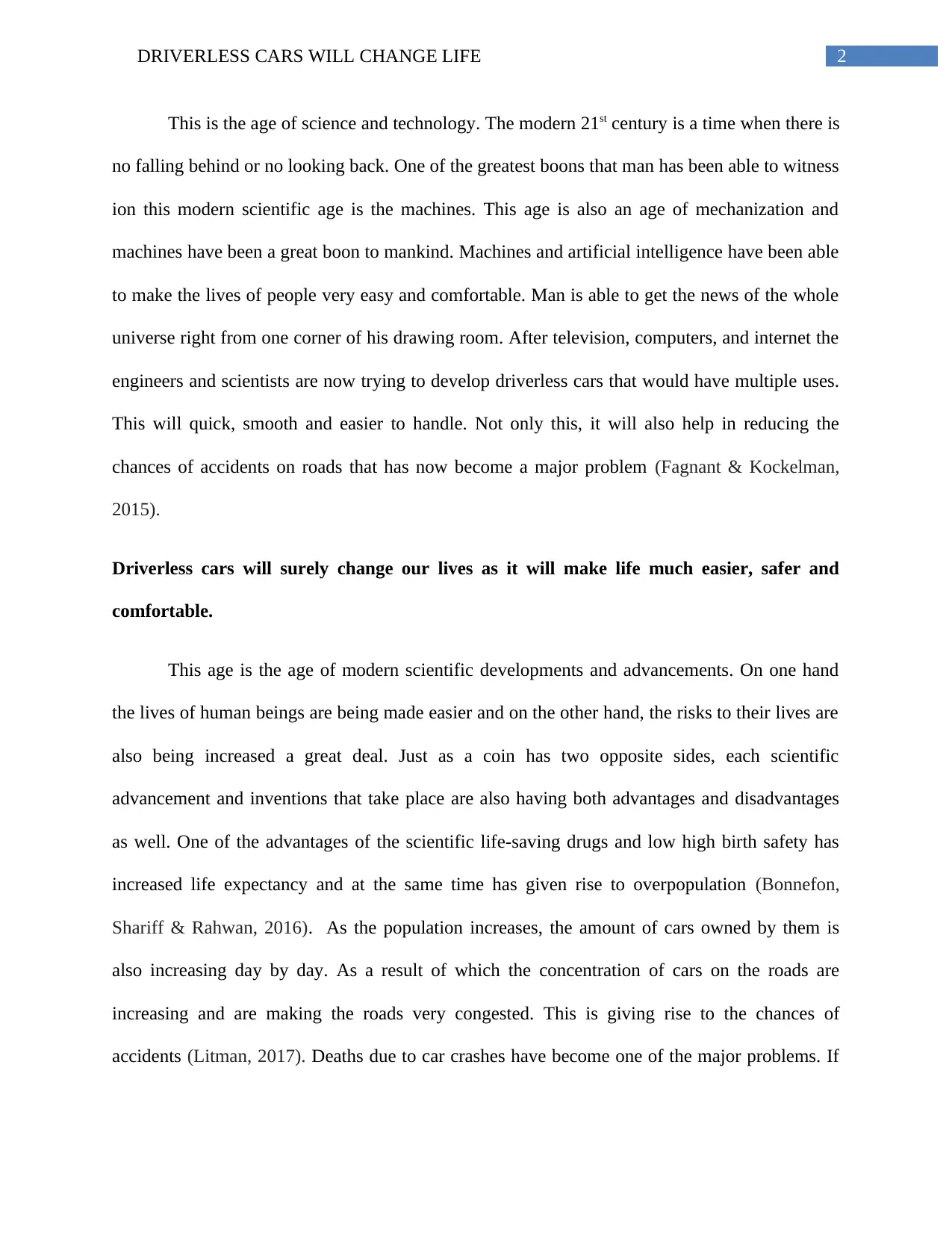
2DRIVERLESS CARS WILL CHANGE LIFE
This is the age of science and technology. The modern 21st century is a time when there is
no falling behind or no looking back. One of the greatest boons that man has been able to witness
ion this modern scientific age is the machines. This age is also an age of mechanization and
machines have been a great boon to mankind. Machines and artificial intelligence have been able
to make the lives of people very easy and comfortable. Man is able to get the news of the whole
universe right from one corner of his drawing room. After television, computers, and internet the
engineers and scientists are now trying to develop driverless cars that would have multiple uses.
This will quick, smooth and easier to handle. Not only this, it will also help in reducing the
chances of accidents on roads that has now become a major problem (Fagnant & Kockelman,
2015).
Driverless cars will surely change our lives as it will make life much easier, safer and
comfortable.
This age is the age of modern scientific developments and advancements. On one hand
the lives of human beings are being made easier and on the other hand, the risks to their lives are
also being increased a great deal. Just as a coin has two opposite sides, each scientific
advancement and inventions that take place are also having both advantages and disadvantages
as well. One of the advantages of the scientific life-saving drugs and low high birth safety has
increased life expectancy and at the same time has given rise to overpopulation (Bonnefon,
Shariff & Rahwan, 2016). As the population increases, the amount of cars owned by them is
also increasing day by day. As a result of which the concentration of cars on the roads are
increasing and are making the roads very congested. This is giving rise to the chances of
accidents (Litman, 2017). Deaths due to car crashes have become one of the major problems. If
This is the age of science and technology. The modern 21st century is a time when there is
no falling behind or no looking back. One of the greatest boons that man has been able to witness
ion this modern scientific age is the machines. This age is also an age of mechanization and
machines have been a great boon to mankind. Machines and artificial intelligence have been able
to make the lives of people very easy and comfortable. Man is able to get the news of the whole
universe right from one corner of his drawing room. After television, computers, and internet the
engineers and scientists are now trying to develop driverless cars that would have multiple uses.
This will quick, smooth and easier to handle. Not only this, it will also help in reducing the
chances of accidents on roads that has now become a major problem (Fagnant & Kockelman,
2015).
Driverless cars will surely change our lives as it will make life much easier, safer and
comfortable.
This age is the age of modern scientific developments and advancements. On one hand
the lives of human beings are being made easier and on the other hand, the risks to their lives are
also being increased a great deal. Just as a coin has two opposite sides, each scientific
advancement and inventions that take place are also having both advantages and disadvantages
as well. One of the advantages of the scientific life-saving drugs and low high birth safety has
increased life expectancy and at the same time has given rise to overpopulation (Bonnefon,
Shariff & Rahwan, 2016). As the population increases, the amount of cars owned by them is
also increasing day by day. As a result of which the concentration of cars on the roads are
increasing and are making the roads very congested. This is giving rise to the chances of
accidents (Litman, 2017). Deaths due to car crashes have become one of the major problems. If
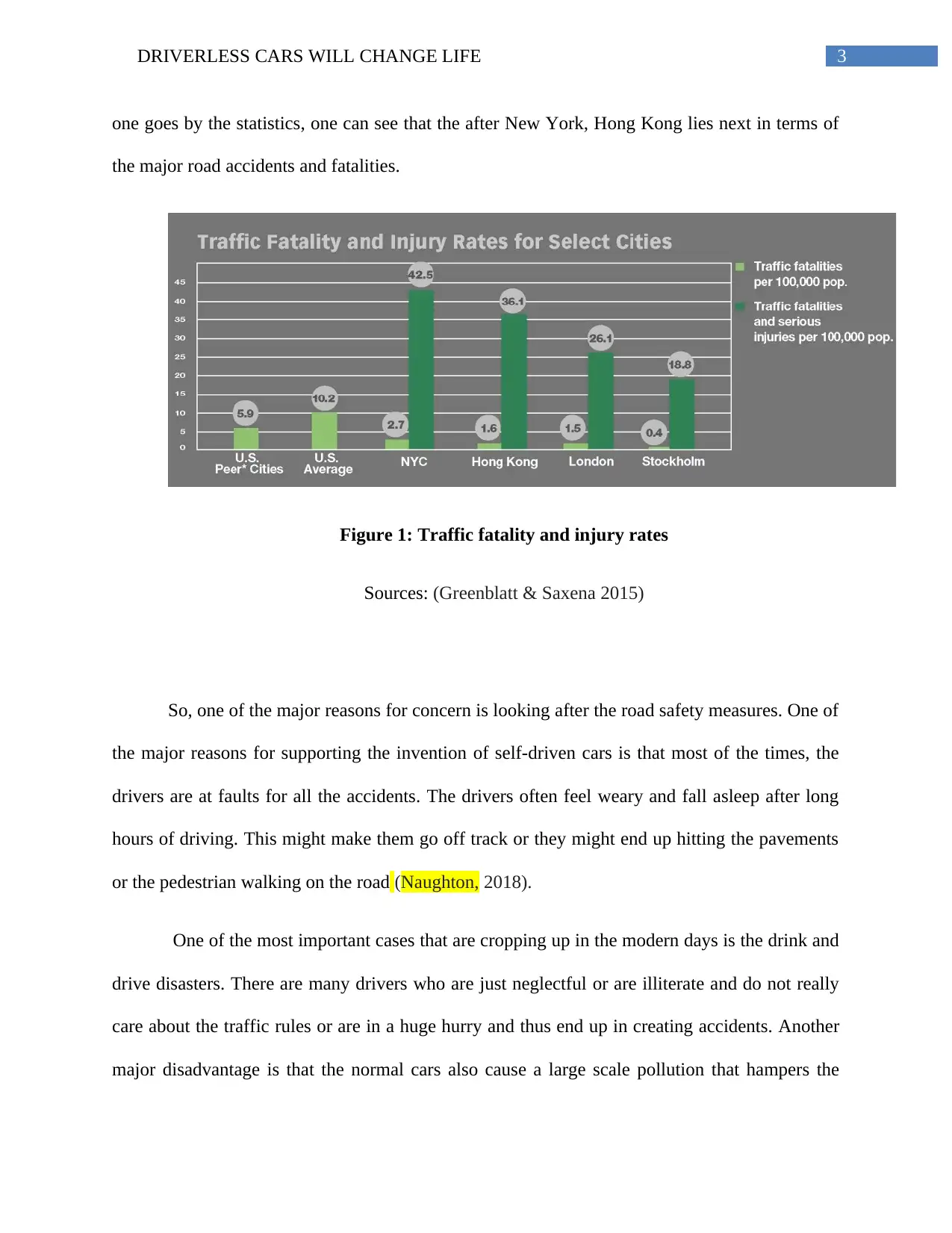
3DRIVERLESS CARS WILL CHANGE LIFE
one goes by the statistics, one can see that the after New York, Hong Kong lies next in terms of
the major road accidents and fatalities.
Figure 1: Traffic fatality and injury rates
Sources: (Greenblatt & Saxena 2015)
So, one of the major reasons for concern is looking after the road safety measures. One of
the major reasons for supporting the invention of self-driven cars is that most of the times, the
drivers are at faults for all the accidents. The drivers often feel weary and fall asleep after long
hours of driving. This might make them go off track or they might end up hitting the pavements
or the pedestrian walking on the road (Naughton, 2018).
One of the most important cases that are cropping up in the modern days is the drink and
drive disasters. There are many drivers who are just neglectful or are illiterate and do not really
care about the traffic rules or are in a huge hurry and thus end up in creating accidents. Another
major disadvantage is that the normal cars also cause a large scale pollution that hampers the
one goes by the statistics, one can see that the after New York, Hong Kong lies next in terms of
the major road accidents and fatalities.
Figure 1: Traffic fatality and injury rates
Sources: (Greenblatt & Saxena 2015)
So, one of the major reasons for concern is looking after the road safety measures. One of
the major reasons for supporting the invention of self-driven cars is that most of the times, the
drivers are at faults for all the accidents. The drivers often feel weary and fall asleep after long
hours of driving. This might make them go off track or they might end up hitting the pavements
or the pedestrian walking on the road (Naughton, 2018).
One of the most important cases that are cropping up in the modern days is the drink and
drive disasters. There are many drivers who are just neglectful or are illiterate and do not really
care about the traffic rules or are in a huge hurry and thus end up in creating accidents. Another
major disadvantage is that the normal cars also cause a large scale pollution that hampers the
⊘ This is a preview!⊘
Do you want full access?
Subscribe today to unlock all pages.

Trusted by 1+ million students worldwide
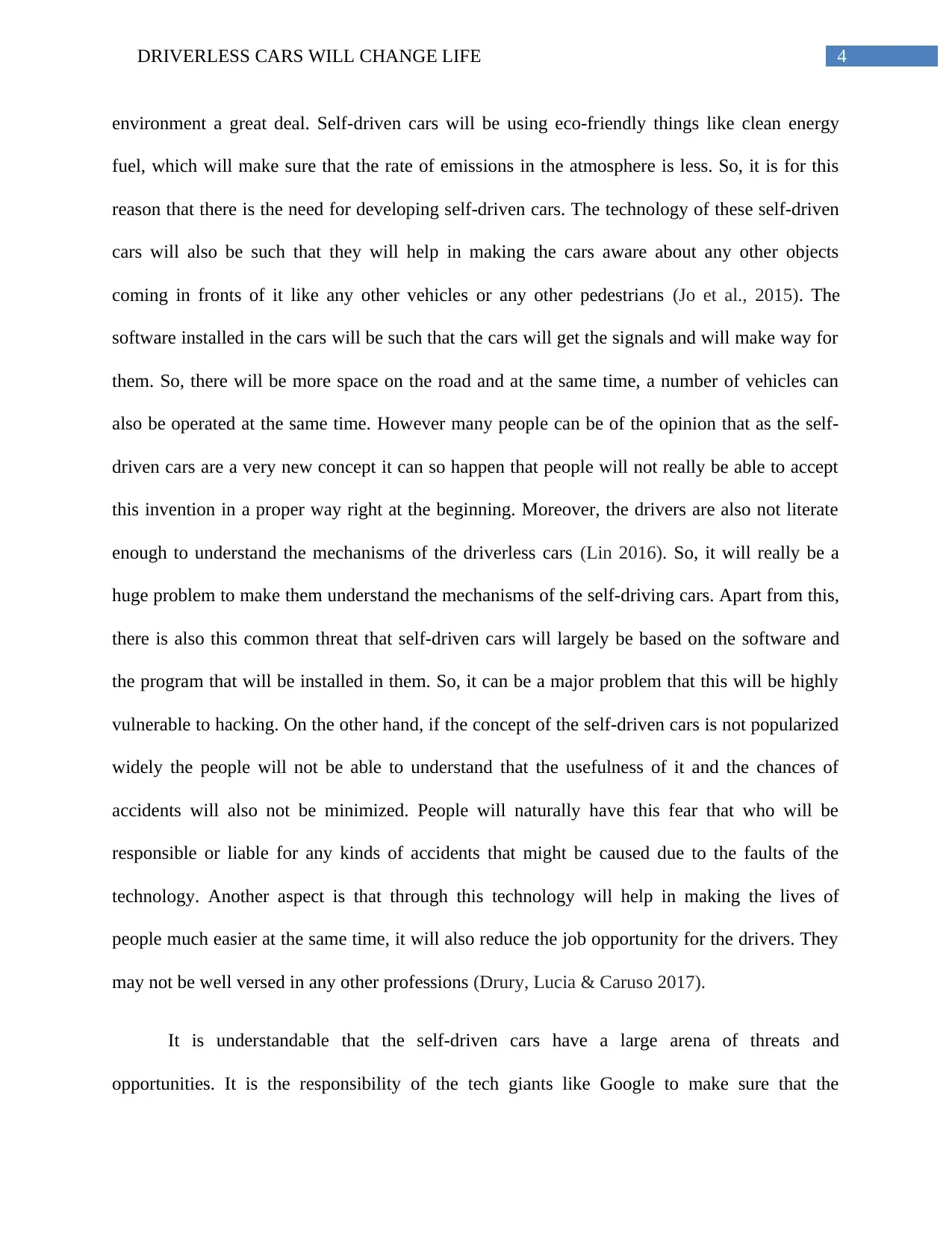
4DRIVERLESS CARS WILL CHANGE LIFE
environment a great deal. Self-driven cars will be using eco-friendly things like clean energy
fuel, which will make sure that the rate of emissions in the atmosphere is less. So, it is for this
reason that there is the need for developing self-driven cars. The technology of these self-driven
cars will also be such that they will help in making the cars aware about any other objects
coming in fronts of it like any other vehicles or any other pedestrians (Jo et al., 2015). The
software installed in the cars will be such that the cars will get the signals and will make way for
them. So, there will be more space on the road and at the same time, a number of vehicles can
also be operated at the same time. However many people can be of the opinion that as the self-
driven cars are a very new concept it can so happen that people will not really be able to accept
this invention in a proper way right at the beginning. Moreover, the drivers are also not literate
enough to understand the mechanisms of the driverless cars (Lin 2016). So, it will really be a
huge problem to make them understand the mechanisms of the self-driving cars. Apart from this,
there is also this common threat that self-driven cars will largely be based on the software and
the program that will be installed in them. So, it can be a major problem that this will be highly
vulnerable to hacking. On the other hand, if the concept of the self-driven cars is not popularized
widely the people will not be able to understand that the usefulness of it and the chances of
accidents will also not be minimized. People will naturally have this fear that who will be
responsible or liable for any kinds of accidents that might be caused due to the faults of the
technology. Another aspect is that through this technology will help in making the lives of
people much easier at the same time, it will also reduce the job opportunity for the drivers. They
may not be well versed in any other professions (Drury, Lucia & Caruso 2017).
It is understandable that the self-driven cars have a large arena of threats and
opportunities. It is the responsibility of the tech giants like Google to make sure that the
environment a great deal. Self-driven cars will be using eco-friendly things like clean energy
fuel, which will make sure that the rate of emissions in the atmosphere is less. So, it is for this
reason that there is the need for developing self-driven cars. The technology of these self-driven
cars will also be such that they will help in making the cars aware about any other objects
coming in fronts of it like any other vehicles or any other pedestrians (Jo et al., 2015). The
software installed in the cars will be such that the cars will get the signals and will make way for
them. So, there will be more space on the road and at the same time, a number of vehicles can
also be operated at the same time. However many people can be of the opinion that as the self-
driven cars are a very new concept it can so happen that people will not really be able to accept
this invention in a proper way right at the beginning. Moreover, the drivers are also not literate
enough to understand the mechanisms of the driverless cars (Lin 2016). So, it will really be a
huge problem to make them understand the mechanisms of the self-driving cars. Apart from this,
there is also this common threat that self-driven cars will largely be based on the software and
the program that will be installed in them. So, it can be a major problem that this will be highly
vulnerable to hacking. On the other hand, if the concept of the self-driven cars is not popularized
widely the people will not be able to understand that the usefulness of it and the chances of
accidents will also not be minimized. People will naturally have this fear that who will be
responsible or liable for any kinds of accidents that might be caused due to the faults of the
technology. Another aspect is that through this technology will help in making the lives of
people much easier at the same time, it will also reduce the job opportunity for the drivers. They
may not be well versed in any other professions (Drury, Lucia & Caruso 2017).
It is understandable that the self-driven cars have a large arena of threats and
opportunities. It is the responsibility of the tech giants like Google to make sure that the
Paraphrase This Document
Need a fresh take? Get an instant paraphrase of this document with our AI Paraphraser
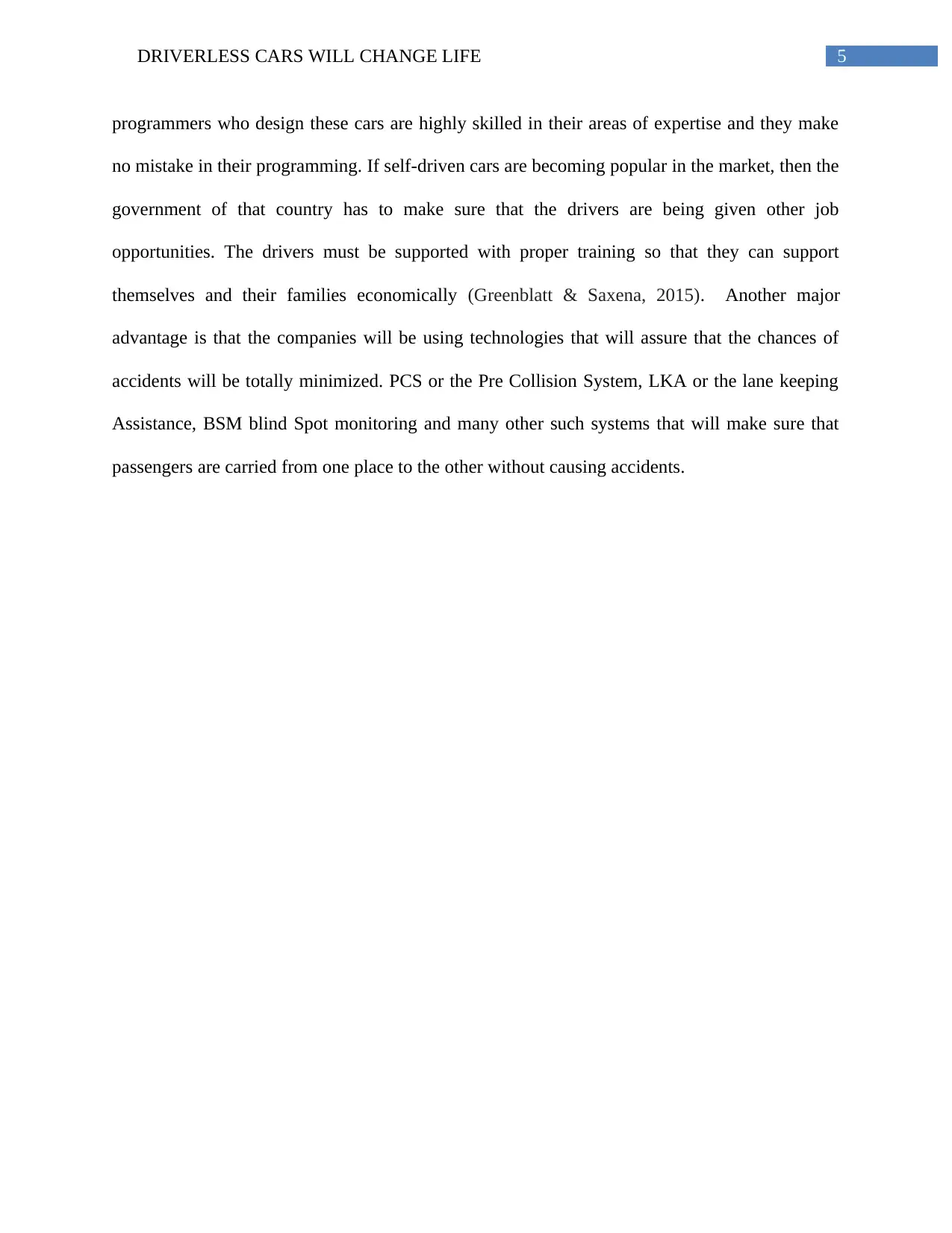
5DRIVERLESS CARS WILL CHANGE LIFE
programmers who design these cars are highly skilled in their areas of expertise and they make
no mistake in their programming. If self-driven cars are becoming popular in the market, then the
government of that country has to make sure that the drivers are being given other job
opportunities. The drivers must be supported with proper training so that they can support
themselves and their families economically (Greenblatt & Saxena, 2015). Another major
advantage is that the companies will be using technologies that will assure that the chances of
accidents will be totally minimized. PCS or the Pre Collision System, LKA or the lane keeping
Assistance, BSM blind Spot monitoring and many other such systems that will make sure that
passengers are carried from one place to the other without causing accidents.
programmers who design these cars are highly skilled in their areas of expertise and they make
no mistake in their programming. If self-driven cars are becoming popular in the market, then the
government of that country has to make sure that the drivers are being given other job
opportunities. The drivers must be supported with proper training so that they can support
themselves and their families economically (Greenblatt & Saxena, 2015). Another major
advantage is that the companies will be using technologies that will assure that the chances of
accidents will be totally minimized. PCS or the Pre Collision System, LKA or the lane keeping
Assistance, BSM blind Spot monitoring and many other such systems that will make sure that
passengers are carried from one place to the other without causing accidents.
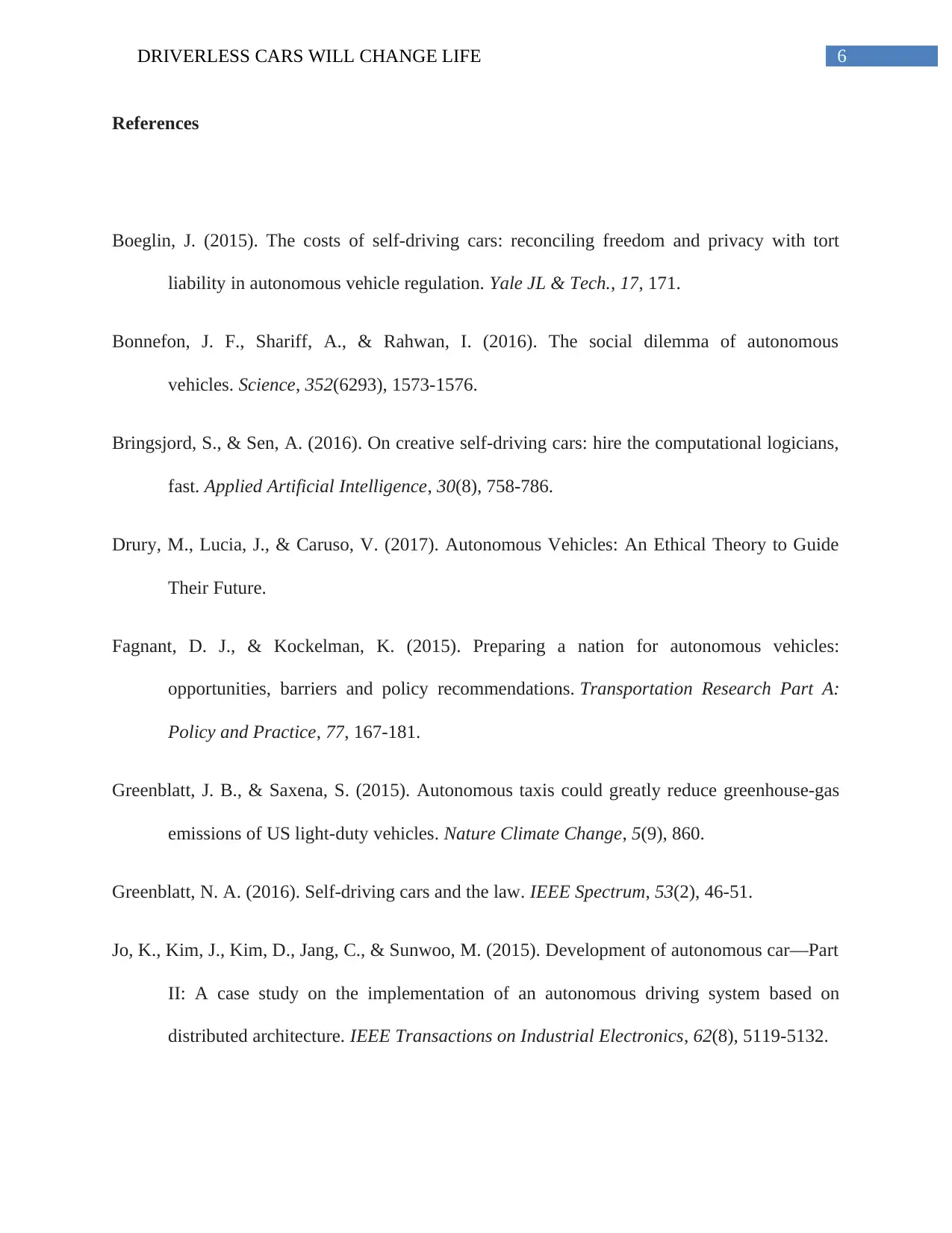
6DRIVERLESS CARS WILL CHANGE LIFE
References
Boeglin, J. (2015). The costs of self-driving cars: reconciling freedom and privacy with tort
liability in autonomous vehicle regulation. Yale JL & Tech., 17, 171.
Bonnefon, J. F., Shariff, A., & Rahwan, I. (2016). The social dilemma of autonomous
vehicles. Science, 352(6293), 1573-1576.
Bringsjord, S., & Sen, A. (2016). On creative self-driving cars: hire the computational logicians,
fast. Applied Artificial Intelligence, 30(8), 758-786.
Drury, M., Lucia, J., & Caruso, V. (2017). Autonomous Vehicles: An Ethical Theory to Guide
Their Future.
Fagnant, D. J., & Kockelman, K. (2015). Preparing a nation for autonomous vehicles:
opportunities, barriers and policy recommendations. Transportation Research Part A:
Policy and Practice, 77, 167-181.
Greenblatt, J. B., & Saxena, S. (2015). Autonomous taxis could greatly reduce greenhouse-gas
emissions of US light-duty vehicles. Nature Climate Change, 5(9), 860.
Greenblatt, N. A. (2016). Self-driving cars and the law. IEEE Spectrum, 53(2), 46-51.
Jo, K., Kim, J., Kim, D., Jang, C., & Sunwoo, M. (2015). Development of autonomous car—Part
II: A case study on the implementation of an autonomous driving system based on
distributed architecture. IEEE Transactions on Industrial Electronics, 62(8), 5119-5132.
References
Boeglin, J. (2015). The costs of self-driving cars: reconciling freedom and privacy with tort
liability in autonomous vehicle regulation. Yale JL & Tech., 17, 171.
Bonnefon, J. F., Shariff, A., & Rahwan, I. (2016). The social dilemma of autonomous
vehicles. Science, 352(6293), 1573-1576.
Bringsjord, S., & Sen, A. (2016). On creative self-driving cars: hire the computational logicians,
fast. Applied Artificial Intelligence, 30(8), 758-786.
Drury, M., Lucia, J., & Caruso, V. (2017). Autonomous Vehicles: An Ethical Theory to Guide
Their Future.
Fagnant, D. J., & Kockelman, K. (2015). Preparing a nation for autonomous vehicles:
opportunities, barriers and policy recommendations. Transportation Research Part A:
Policy and Practice, 77, 167-181.
Greenblatt, J. B., & Saxena, S. (2015). Autonomous taxis could greatly reduce greenhouse-gas
emissions of US light-duty vehicles. Nature Climate Change, 5(9), 860.
Greenblatt, N. A. (2016). Self-driving cars and the law. IEEE Spectrum, 53(2), 46-51.
Jo, K., Kim, J., Kim, D., Jang, C., & Sunwoo, M. (2015). Development of autonomous car—Part
II: A case study on the implementation of an autonomous driving system based on
distributed architecture. IEEE Transactions on Industrial Electronics, 62(8), 5119-5132.
⊘ This is a preview!⊘
Do you want full access?
Subscribe today to unlock all pages.

Trusted by 1+ million students worldwide
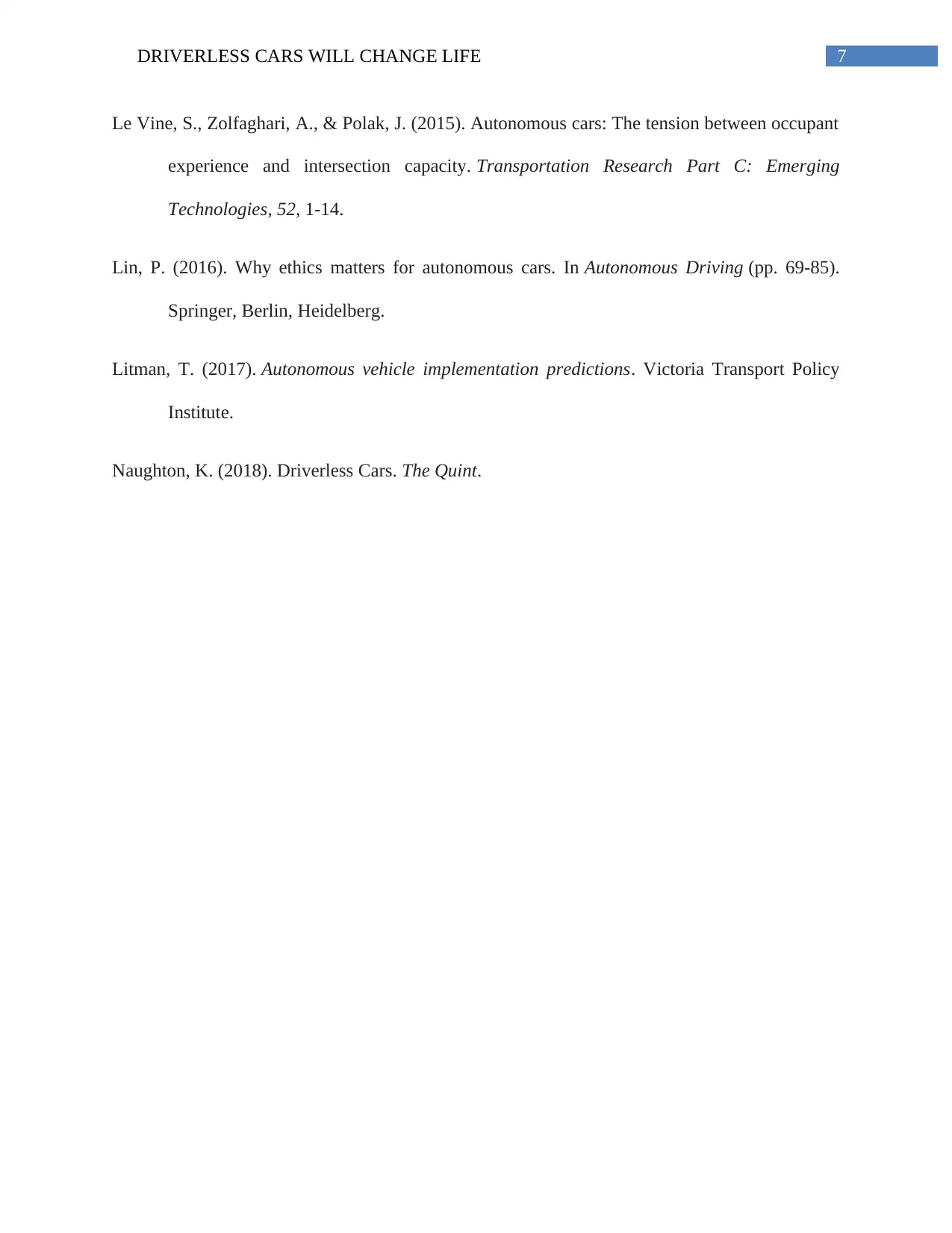
7DRIVERLESS CARS WILL CHANGE LIFE
Le Vine, S., Zolfaghari, A., & Polak, J. (2015). Autonomous cars: The tension between occupant
experience and intersection capacity. Transportation Research Part C: Emerging
Technologies, 52, 1-14.
Lin, P. (2016). Why ethics matters for autonomous cars. In Autonomous Driving (pp. 69-85).
Springer, Berlin, Heidelberg.
Litman, T. (2017). Autonomous vehicle implementation predictions. Victoria Transport Policy
Institute.
Naughton, K. (2018). Driverless Cars. The Quint.
Le Vine, S., Zolfaghari, A., & Polak, J. (2015). Autonomous cars: The tension between occupant
experience and intersection capacity. Transportation Research Part C: Emerging
Technologies, 52, 1-14.
Lin, P. (2016). Why ethics matters for autonomous cars. In Autonomous Driving (pp. 69-85).
Springer, Berlin, Heidelberg.
Litman, T. (2017). Autonomous vehicle implementation predictions. Victoria Transport Policy
Institute.
Naughton, K. (2018). Driverless Cars. The Quint.
1 out of 7
Related Documents
Your All-in-One AI-Powered Toolkit for Academic Success.
+13062052269
info@desklib.com
Available 24*7 on WhatsApp / Email
![[object Object]](/_next/static/media/star-bottom.7253800d.svg)
Unlock your academic potential
Copyright © 2020–2025 A2Z Services. All Rights Reserved. Developed and managed by ZUCOL.




